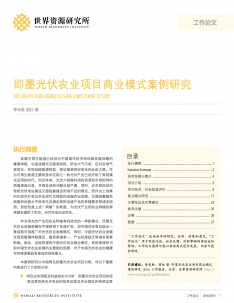Solar PV for Agriculture Jimo Case Study
As a reference for the decision making and practicing in the field, this case study introduced and analyzed the development and business model of the project, and summarized the preferable conditions and safeguard measurements for application and promotion of solar PV for agriculture development in a sustainable and healthy way.

Renewable energy has been one of the most important measures in China for Circular Economy and Low Carbon development strategy, and it is also an inevitable approach to reduce the fossil fuel consumption, to attach to the air pollution, to mitigate climate change, to achieve low carbon energy transformation, and to security of energy supplying.
As one of the key renewable energies technology, solar photovoltaic has stepped into scale up application. However, the growing are facing the issues of the abundant resources areas far from the load areas, the grid connection and adoption, and lack of construction land available for large grid connected PV power stations near to the load. Meanwhile, as a result of land intensive and comprehensive development and agricultural modernization transformation, the modern agriculture development is also facing the embarrassed situation of the high cost of financing, and the lower level of facilities which cannot meet requirement of high value-added plantation. The difficulties of the above both sectors are the chances for the solar PV and agriculture integration, namely solar PV for agriculture.
The solar PV for agriculture is a new development model of combination of solar PV power generation and agricultural plantation. Although so-called solar PV for agriculture models grow rapidly in China, there lacks of mutual models can be summarized for the purpose of promotion and application since various factors impacting this model of the combination, like unclear institutional and management system, inadequate financing resources and modalities, lack of industry standards, etc. There for, it is urgent and meaningful to review and summarize the impact factors which restricted soar PV for agriculture development in China, and to sort out the solutions to address the restrained barriers for the sustainable development of this combination model.
This case study takes China Qingdao Jimo Solar PV for Agriculture Project as an example to introduce and analysis this combination development model of solar PV for agriculture from following aspects:
- Project components and stakeholders.
- Financial, Economic and social benefits.
- Project Development Model.
- Influencing factors to project benefits.
- Project promotion conditions and safeguard measures.